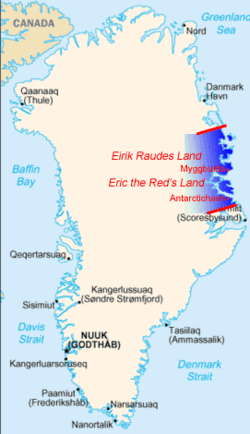- Erik the Red's Land
-
Eirik Raudes Land
Erik the Red's LandUnrecognized territory of Norway ← 
1931–1933  →
→Erik the Red's Land Capital Myggbukta (unofficial)
(Meterological Station)King of Norway - 1931-1933 Haakon VII Governor - 1932-1933 Helge Ingstad History - Royal Norwegian
proclamation10 July 1931 - The International Court
at the Hague awarded
the territory to Denmark5 April 1933 Erik the Red's Land (Norwegian: Eirik Raudes Land) was the name given by Norwegians to an area on the coast of eastern Greenland occupied by Norway in the early 1930s. It was named after Erik the Red, the founder of the first Norse settlements in Greenland in the 10th century. The Permanent Court of International Justice ruled against Norway in 1933 and the country subsequently abandoned its claims.[1]
Contents
Origin of the claim
The first European settlement in Greenland was established by Norse colonists from Iceland around the year 1000. There were two main Norse settlements on Greenland, but both were on the southwestern coast of the island, far away from the area that later became Eirik the Red's Land. From the 1260s the Norse colony in Greenland recognized the King of Norway as its overlord. When Norway was under Danish rule, as part of Denmark-Norway, from the Middle Ages until 1814, official documents made it clear that Greenland was part of Norway.[citation needed] However, contact with the settlements there was lost in the late Middle Ages and the Norse population died out, possibly around 1500.
Centuries later a Dano-Norwegian evangelist, Hans Egede, heard about a Viking colony on Greenland. He then asked King Frederick IV of Denmark for permission to try to find the long-lost colony and eventually to establish a Protestant Christian mission there to convert the population of the land, who were presumed, if any survived, to still be Catholic or to have completely lost the Christian faith. Egede reached Greenland in 1721 and found no Norse population there. He then started his mission among the Inuit people. This led to his becoming known as "The Apostle of Greenland" and appointed Bishop of Greenland. He founded the current capital of Greenland, called Godthaab. In 1723 Det Bergenske Grønlandskompani (The Bergen Greenland Company) received a concession for all trade with Greenland.[2]
For the remainder of the union between Norway and Denmark, the relationship between Greenland and the state was organised in different ways. Modern historians disagree as to what point in history Greenland went from being a Norwegian possession to being a Danish one. However, the Treaty of Kiel, signed in 1814, indicates that Greenland was at least politically regarded as having been Norwegian: "...the Kingdom of Norway ... as well as the dependencies (Greenland, the Faroes and Iceland not included) ... shall for the future belong to ... His Majesty the King of Sweden ...".[3] Norway never recognised the validity of the Treaty of Kiel.
History
In 1919 Denmark claimed the whole of Greenland as its territory, with Norway's acquiescence (see Ihlen Declaration).
However, in 1921 Denmark proposed to exclude all foreigners from Greenland, creating diplomatic conflict until July 1924, when Denmark agreed that Norwegians could establish hunting and scientific settlements north of 60°27' N.
In June 1931 Hallvard Devold, Chairman of the Norwegian Arctic Trading Company, raised the Norwegian flag at Myggbukta and on 10 July 1931 a Norwegian royal proclamation was issued, claiming Eastern Greenland as Norwegian territory. Norway claimed that the area was terra nullius: it had no permanent inhabitants and was for the most part used by Norwegian whalers and trappers. The area was defined as "situated between Carlsberg Fjord in the South and Bessel Fjord in the North", extending from latitude 71°30' to latitutde 75°40'N. Although it was not explicitly stated in the proclamation itself, it was assumed that the area was limited to the eastern coast, so that the Inland Ice constituted its western limit. (The Inland Ice covers five sixths of Greenland's total area, so that only a narrow strip of varying width along the coast is free of permanent ice.)
Norway and Denmark agreed to settle their dispute over Eastern Greenland at the Permanent Court of International Justice in 1933. Norway lost and after the ruling it abandoned its claim.
During Norway's 1940-1945 occupation by Nazi Germany in World War II, the territorial claim was briefly revived by the puppet Quisling regime, who extended it to cover all of Greenland. A small-scale invasion to "reconquer" the island for Norway was proposed by Vidkun Quisling, but the Germans rejected this after deeming it unfeasible in light of the then-ongoing Battle of the Atlantic.[4]
References
- ^ Legal Status of Eastern Greenland, PCIJ Series A/B No. 53 (1933)
- ^ http://www.karmoybladet.no/nyhet.cfm?nyhetid=218
- ^ "Dessa Biskopsdömen, Stift och Provinser, innefattande hela Konunga-Riket Norrige med alla dess Inbyggare, Städer, Hamnar, Fästningar, Byar och Öar utmed hela detta Rikes kuster, tillika med deras tillhörigheter (Grönland, Ferröarne och Island här under likwäl icke inbegripne); äfwensom de med alla förmoner, rättigheter och afkastningar skola hädanefter under full ägo och öfwerherreskap tillhöra Hans Maj:t Konungen af Swerige, och utgöra ett Konunga-Rike förenadt med Swerige.", The Treaty of Kiel (Swedish)
- ^ Buskø-affæren - hvordan ei norsk selfangstskute ble USAs første fangst i andre verdenskrig, Artikkel i tidsskriftet Historie nr 1, 2007
External links
Categories:- States and territories established in 1931
- States and territories disestablished in 1933
- History of Greenland
- History of Norway
- Former Norwegian colonies
- Permanent Court of International Justice cases
- 1933 in international relations
Wikimedia Foundation. 2010.


